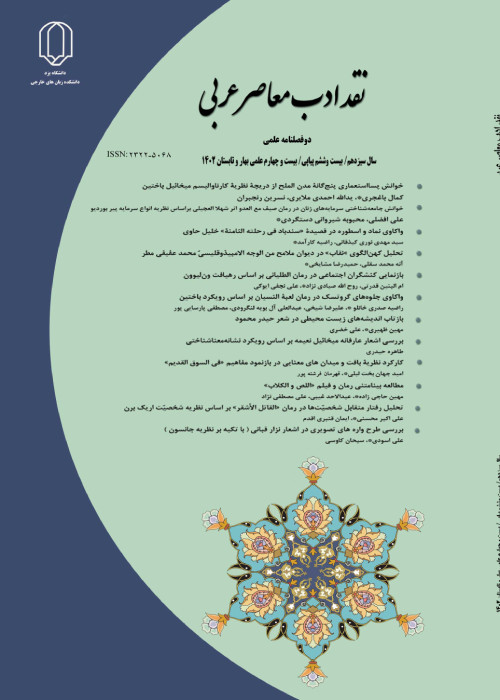Semiotics of the concept of temporal-spatial homelessness in the Ahzan al-Sunnah al-Iraqi anthology by Khazal al-Majedi based on Pierce's theory
Semiotics is one of the new methods in literary criticism of texts. Based on the principles of semiotics, researchers analyze the hidden and internal data of the text and the relations among the words in the context and reveal and interpret semantic secrets and signs in poetic texts. The science of semiotics entered a new phase in the 1960s with the rise of the French linguist Ferdinand Desoussor, but it was not long before the American Charles Pierce revolutionized the science of semiotics by presenting his threefold model. According to him, man lives in a complex system of a wide range of signs. By recognizing these signs, he comes to an understanding of existence. Hence, Pierce presents a three-dimensional model in which there is an inextricable link among the three parts. Pierce defines the concept of sign in three parts, including a) representation, which is a form that assumes a sign, not necessarily material, equivalent to ‘signifier’ in Saussure's view, b) object, as something to which the sign refers, and c) interpretant, as a meaning derived from a sign and a perception created by a sign. Interpretation is equivalent to meaning in Saussure's view.According to Pierce's theory, the sign has another classification, which is based on its characteristics. Pierce's semiotics is based on three philosophical categories, namely primacy, secondary, and tertiary. The category of priority includes matters that exist in themselves and without regard to any other relationship, such as whiteness or feelings of sadness, without questioning the cause. Pierce's second category is secondary to various components, including effects. For example, falling of a stone thrown on the ground and pain in terms of its cause are part of this category. The category of the secondary is more related to the practical life and personal experience of man. The third and last category is the category of the tertiary, which deals with general laws and objects. In fact, it relates the categories of priority and secondary. The connection among these three categories produces the concept of a sign.
Khazal Al-Majedi (1951) is one of the poets of modernity whose main poetic theme is the grief of homelessness and distance from home. He is an educated poet and is aware of the history of Iraq. The present study intends to examine the concepts of homelessness and alienation with an analytical-descriptive method in the Ahzan al-Sunnah al-Iraqi anthology by Khazal al-Majedi based on Pierce's theory. The poet's skill in choosing specific implications from the meanings is explored, multiple implications are derived from his vocabulary, and criticisms are made on the role of temporal and spatial coders in shaping vocabulary symptoms related to homelessness.
Since Al-Majedi's poems have a very high interpretive capacity and the study of the relationship between signs and codes in his poetry leads the reader to a correct understanding of his thoughts and the depth of his concepts and goals, Pierce's semiotic pattern was used to illuminate the underlying layers of his poems. In this research, in order to obtain the required data, previous findings and the relationships among them as well as the available valid sources have been used. The research is conducted based on the analysis of Khazal Al-Majedi's works so as to introduce the poet’s style and views, with a focus on the Ahzan al-Sunnah of Iraqi anthology and the books in the field of semiotics and content analysis.
Based on the research results, these cryptocurrencies have been used with the aim of beautifying words, increasing the semantic capacity of words and creating new and unfamiliar semantic combinations. They create images in the poems in line with their general atmosphere and reflect Al-Majedi's extra-textual factors, worldview, nostalgic emotions, feelings of homesickness, and intense attachment to his homeland.
Using spatial situations and spatial constraints, the poet has created a poetic space in which a system of interconnected meanings has been formed, giving the concept of sign a visual dimension and using the physical properties of place and homelessness. He has loneliness, which is abstract and intangible, or visible and tangible. He gives it a sensory nature so that the reader can reach the depths of his emotions, alienation and sorrow and sympathize with him.In his poetry, Al-Majedi uses the element of time as a form and container that illustrates all his memories and emotional experiences. This is done by using metaphors and similes and turning time units into poetic signs and the concepts of homelessness and bitterness. He expresses distressing moments away from home in indirect language. These time and space vessels depict his intense attachment to his homeland, show an emotional and cultural burden, and reflect the world inside the poet and his tired soul.He creates a chain of images, signs and meanings by arranging explicit meanings in the text of the poem. He also produces successive and related poetic images and uses the spice of imagination and permissible language to target the reader's mind. The main and hidden meaning behind these words are well deliberated, and the symbols of homelessness in his poems are the product of the transition from the phonetic form of words and temporal and spatial constraints and the surface texture of the text to the abstract interpretation and meaning of the sign, which is interpreted with the help of a subject in the real and external world.
- حق عضویت دریافتی صرف حمایت از نشریات عضو و نگهداری، تکمیل و توسعه مگیران میشود.
- پرداخت حق اشتراک و دانلود مقالات اجازه بازنشر آن در سایر رسانههای چاپی و دیجیتال را به کاربر نمیدهد.




